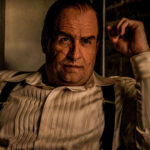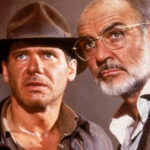

The movie ‘Halloween’, released in 1978, is an iconic work in the horror genre that has left a lasting impact on generations. Directed by John Carpenter, this cinematic classic not only set the standards for future horror films but also introduced fascinating trivia surrounding its production. From the casting of the renowned actor Nick Castle as the villain Michael Myers to the iconic mask of the character, originally a simple mold of William Shatner, many behind-the-scenes details contributed to the creation of this suspense masterpiece.
In this analysis, we’ll delve into some of the most interesting behind-the-scenes trivia that made ‘Halloween’ a lasting cultural phenomenon.
1 – THE CASTING OF JAMIE LEE CURTIS
At only 19 years old and with minimal acting experience, John Carpenter made a bold choice in selecting Jamie Lee Curtis as part of his homage to the renowned filmmaker Alfred Hitchcock in the production of “Halloween”. An admirer of Hitchcock classics such as “Vertigo” (1958) and “The Birds” (1963), Carpenter saw in Curtis the opportunity to pay tribute to the master of suspense.
Curtis’s connection to Hitchcock’s universe is even more noteworthy as she is the daughter of Janet Leigh, the protagonist of “Psycho” (1960), one of Hitchcock’s most iconic films. This familial link was instrumental in Carpenter offering Jamie the role of Laurie Strode, the pursued and innocent protagonist of “Halloween”.
2 – ACTRESS THOUGHT SHE WOULD BE FIRED
Despite starting her career quietly, appearing in television series such as “Charlie’s Angels,” “The Hardy Boys/Nancy Drew Mysteries,” and “Columbo,” Jamie Lee Curtis took her first steps into the world of cinema in “Halloween”. The actress later admitted that this new challenge left her feeling quite insecure.
After the end of the first day of filming, Jamie returned home disheartened with her performance. Some time later, she received a call from John Carpenter. Believing she was going to be fired, she was surprised to hear praise from the director, who expressed being very pleased with her work so far. Carpenter’s gesture of recognition brought confidence to the actress to face the upcoming days of filming.
3 – MILLION-DOLLAR BOX OFFICE
“Halloween” was produced on a modest budget by the standards of its time, totaling just $300,000 to bring the script to life. Despite the limited resources, the film proved to be a massive box office success. With a gross of over $70 million, it became, for many years, the most profitable independent horror film in cinema history. It wasn’t until 1999 that this record was surpassed by the release of “The Blair Witch Project”.
4 – CUTTING-EDGE CAMERAS
Despite facing budget constraints, John Carpenter chose to invest considerably in the cameras used in “Halloween”. Opting for top-of-the-line Panavision equipment, which cost around $70,000, nearly a quarter of the total production budget.
Among these cameras, the Panaglide stood out as a distinct technology from the traditional ones available on the market. While most cameras were stationary, the Panaglide allowed for movement. This innovation was essential for Carpenter to create a unique cinematic experience, providing the audience with the sensation of exploring the film’s settings, which significantly contributed to the immersion and suspense of the work.
5 – THE ICONIC MASK IS FROM ANOTHER FAMOUS MOVIE CHARACTER
As the production team sought an identity for “The Shape,” the name by which the killer Michael Myers is known, editor and designer Tommy Lee Wallace was tasked with finding the perfect mask to cover the face of Nick Castle, the actor portraying the villain.
Exploring Hollywood Boulevard, Wallace visited Bert Wheeler Hollywood Magic, a renowned store known for its monstrous latex masks, particularly popular in the 1960s. Among the options were models based on the faces of President Richard Nixon and Mr. Spock, but it was the mask of James Tiberius Kirk, the captain of the USS Enterprise in the classic series “Star Trek,” that caught his attention.
After acquiring the mask, Wallace made several modifications, including painting the hair dark brown, giving it a new cut, and applying white paint to the rest. Thus, the face of Michael Myers became an adaptation of the features of actor William Shatner.
6 – BASED ON TRUE EVENTS
Before becoming the relentless killer who stalks Laurie Strode, Michael Myers spent years of his life confined in an institution under the care of Dr. Sam Loomis (Donald Pleasence).
This conception has its roots in John Carpenter’s personal memories. During his college days, the filmmaker visited a psychiatric hospital, where he had a memorable encounter with a child. Carpenter recalls that the boy’s gaze was piercing, imbued with a sinister aura that deeply disturbed him. This feeling of fear and discomfort he experienced at the time served as direct inspiration for the creation of the character of Myers.
7 – WE NEED PUMPKINS
The Halloween celebrations, the setting for the events of the film, are filled with symbols in the United States, and one of the most emblematic is pumpkins. It was unthinkable to make a movie about this date without their presence.
However, filming took place during springtime in California, a time when obtaining pumpkins is a difficult task. This led the crew to the brink of despair. With great effort, only three specimens were obtained, and one of them needed to be destroyed in one of the scenes. Under tremendous pressure, Carpenter managed to film the sequence in a single take, bringing together the entire crew and cast in a moment of tension that culminated in success.
8 – UNFORGETTABLE SOUNDTRACK
Alongside his then-wife, Debra Hill, John Carpenter not only directed and co-wrote the screenplay for “Halloween,” but also made another significant contribution to the production: he composed the film’s unmistakable soundtrack.
The music, which employs the unusual 5/4 time signature, a musical technique Carpenter learned from his father, was created in just four days. It is undoubtedly one of the most chilling and recognizable features of the film.
9 – BABYSITTER KILLERS
Certainly, “The Babysitter Murders” was a possibility for the film’s title.
According to Irwin Yablans, the producer and distributor of the film, the initial idea for the script came from him and his wife. Originally, the planned events spanned several days. However, due to budget constraints, Debra and John chose to focus the horror on a single night. This decision aimed to reduce the need for multiple costumes and sets, and the chosen day was Halloween. That’s how the final title of the project was established.
10 – MIKE MYERS IS A REAL NAME
The name Michael Myers had a curious connection to the film “Assault on Precinct 13” (1976), the second film in John Carpenter’s career, which was the name of the distributor of the film in Europe. The “original Myers” even entered the film into competitive showcases, contributing to its success in England, surpassing even its reception in the United States.
As a way of thanking for this support, albeit in a rather peculiar manner, Carpenter decided to name the villain of his next film as Michael Myers. However, the real Michael Myers didn’t initially seem pleased with the homage, and years after the film’s success, he made a joke suggesting that the production should pay him royalties for the unauthorized use of his name.
The 1978 film “Halloween” remains not only a classic of the horror genre but also an endless source of curiosities and fascinating behind-the-scenes details. From the meticulous choice of Michael Myers’ iconic mask to the inspiration for the chilling soundtrack composed by John Carpenter, every aspect of the production reveals an intriguing story. Through the director’s personal reminiscences and the creative decisions made by the team, emerge elements that contributed to the construction of this terrifying universe that persists decades after its release. “Halloween” is not just a movie but a cultural phenomenon that continues to captivate and haunt audiences worldwide, solidifying its place as a masterpiece of cinematic suspense.








